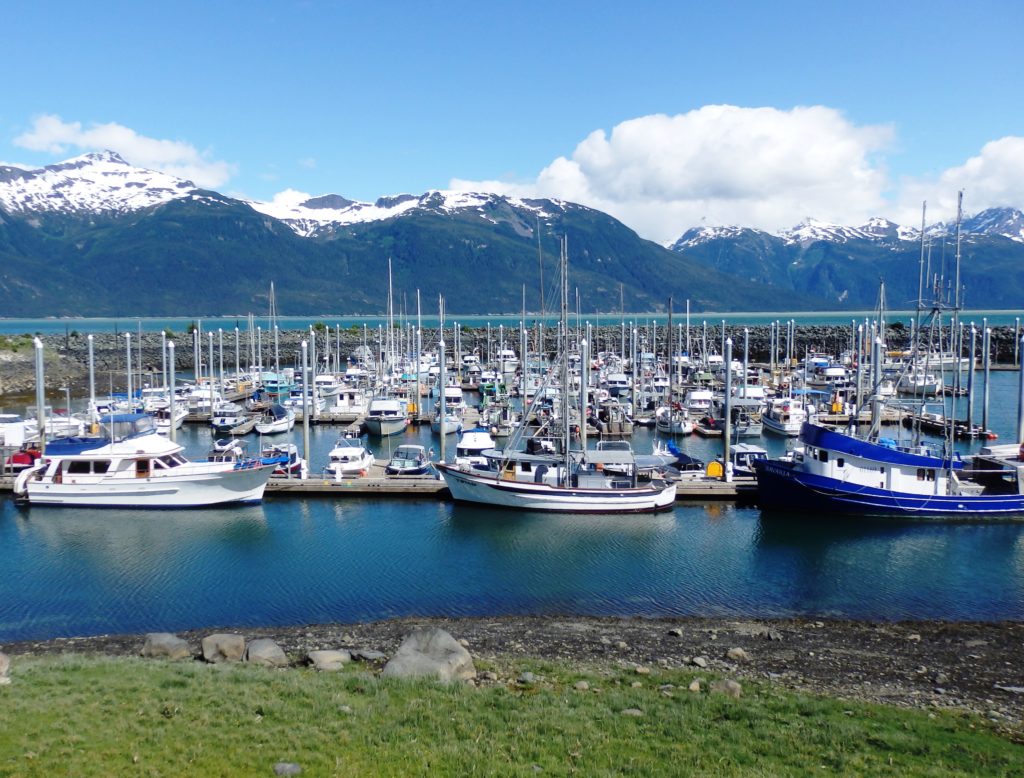
The Haines Portage Cove Harbor. (Emily Files)
Lynn Canal fishermen experienced a second round of strong chum salmon harvests this (last) week. Though the waters of District 15 were only open for two days, the chum catch far exceeded other districts in the region.
At 125,000 fish, the chum harvest in District 15 was more than double that of the next strongest district in the region.
“We’ve got a strong return of DIPAC chum, enhanced chum returning to the boat harbor terminal harvest area,” says Wyatt Rhea-Fournier, a management biologist with the Alaska Department of Fish and Game in Haines. “And also to the Amalga Harbor terminal harvest area. So we attracted, I estimated about 175 boats when I was down on the grounds on Monday.”
Rhea-Fournier says that’s despite new restrictions meant to reduce the harvest of king salmon returning to the Chilkat River.
Commercial openings have been limited in time and area. ADF&G has also implemented a six inch maximum net restriction and night closures.
“We’ve been able to reduce our Chinook harvest substantially,” says Rhea-Fournier. “Looks like we’re about half of what we’ve caught on average over the last 10 years. And if we compare it to last year, we’re about a third of what we caught last year for king salmon. That has come with some limited time and some limited area. But we still have been able to pull in a lot of chum.”
Rhea-Fournier says the catch-per-unit effort and number of fish caught per boat are about the same as last year.
While conservation measures appear to be working, Rhea-Fournier reminds fishermen that they are still following a king salmon conservation management plan.
“So we’re of course asking all of our commercial fishermen in the fleet, that if they do harvest any Chinook salmon or take and Chinook salmon home for personal use, to of course please mark that on your fish ticket,” says Rhea-Fournier. “The more information we have, the better we can do at managing our resource.”
While the chum return remains strong, Rhea-Fournier says sockeye are slow to arrive. Fish and Game monitors chinook at sockeye returning to the Chilkoot and Chilkat Rivers. And, the season started with a period of low water.
“And all of us that were here in town this winter know kind of what a weird winter it was,” says Rhea-Fournier. “We didn’t have a lot of snowpack, but we had a lot of freezing. So as the sun finally came out on us in the Upper Lynn Canal, there wasn’t a lot of snow on the hills to melt. There wasn’t a lot of water in the river. When we started out fish wheels and fish weirs, we had some of the lowest water levels we’d ever seen, when we started those escapement projects.”
Rhea-Fournier says, while things are starting to pick up on the Chilkoot River, the Chilkat remains very slow.
Low sockeye numbers aren’t isolated to the Upper Lynn Canal. Rhea-Fournier says it’s a trend throughout the state.
“And when you have sockeye salmon that are showing weak returns, and they’re going to different rivers, that kind of tells you there was a problem probably out in the Gulf of Alaska,” says Rhea-Fournier. “Probably out in their feeding and growing area. And these fish would have been heading out into the ocean in 2013 and 2014, which was kind of the tail end of that warm blob episode.”
ADF&G monitors sockeye stocks at a weir on the Chilkoot. That’s an area of concern for safety, because of the convergence of fish, bears and human visitors.
The conversation about safety on the corridor has ramped up this year. The Haines Assembly imposed a moratorium on permits for new tours visiting the area.
Rhea-Fournier says Fish and Game is ramping up its efforts to improve safety, as well.
“We’ve been putting some of our department staff out there on our big cruise ship days,” says Rhea-Fournier. “So when we have big boats coming in on Wednesday, every once in a while a big boat on Tuesday, you’ll see one of the Department of Fish and Game’s commercial fisheries division staff members out there.”
Rhea-Fournier says new lines have been painted and new signs raised. And, the Parks Service put up an information kiosk with educational pamphlets.









Record High Enhanced Chum returns, record low Sockeye and King Salmon returns. Get it? Fish and game is failing the Alaskan Citizens by failing to manage the fish stocks for sustainable harvest. The Alaskan Constitution requires that the State (Fish and Game) manage the fisheries for sustainable harvest. Fish and Game is failing to protect the resources that they are responsible for. Quit tagging fish, stop harvesting king salmon. Stop enhancing the Chum, start protecting the Kings.
Record High enhanced chum, record low King and Sockeye, Fish and Game apparently does not understand what the word sustainable means, and should manage the resources in a sustainable fashion as the Alaska Constitution requires.